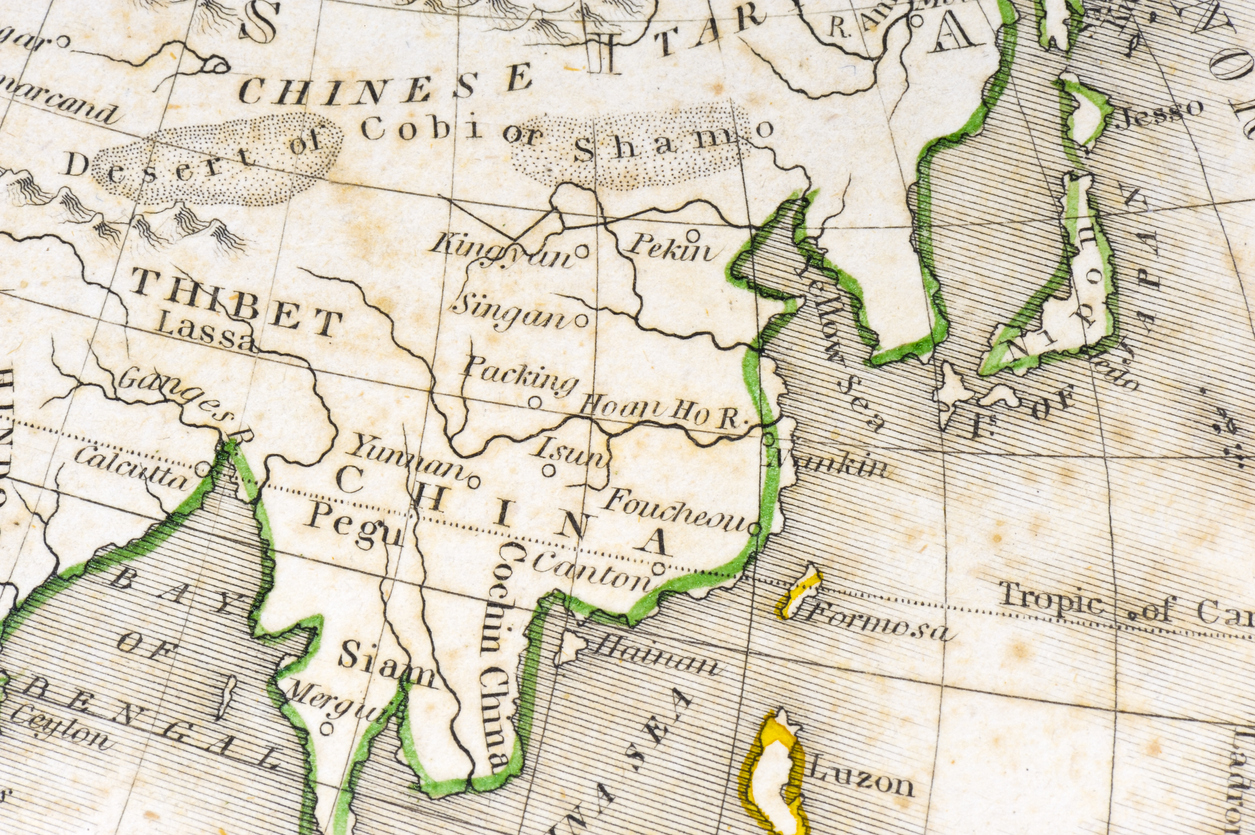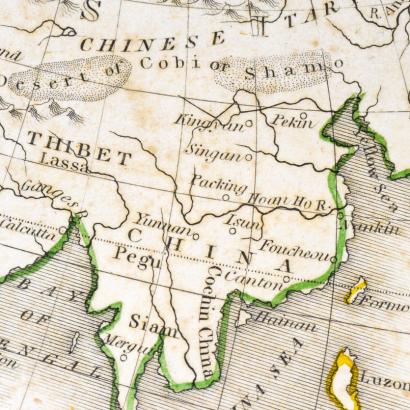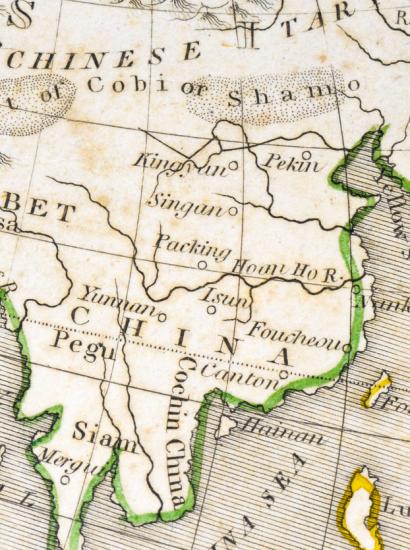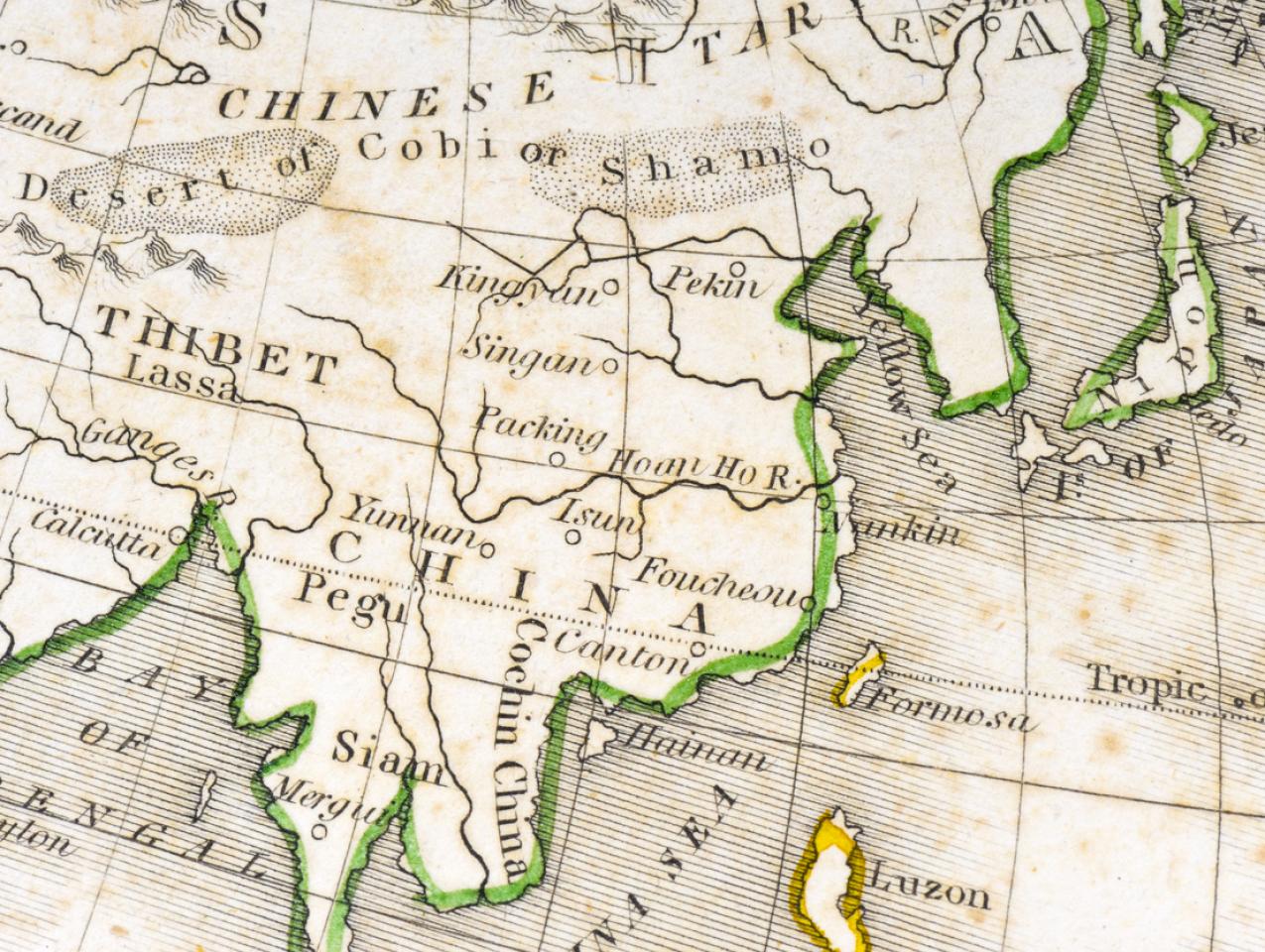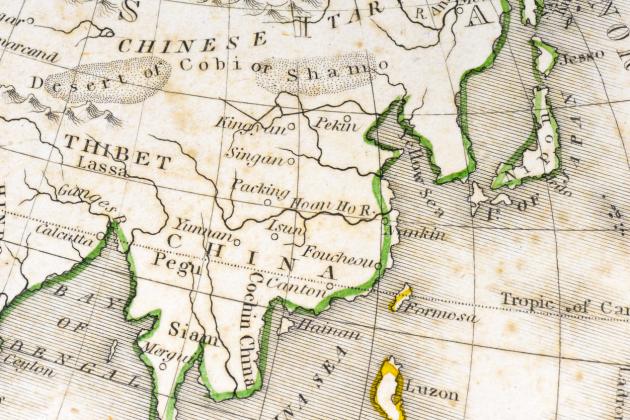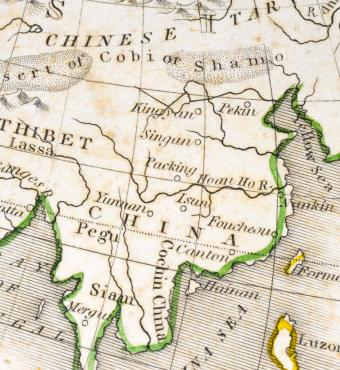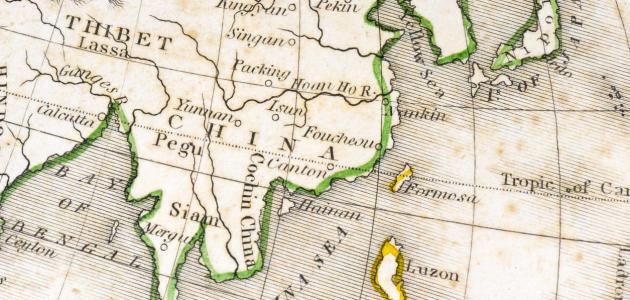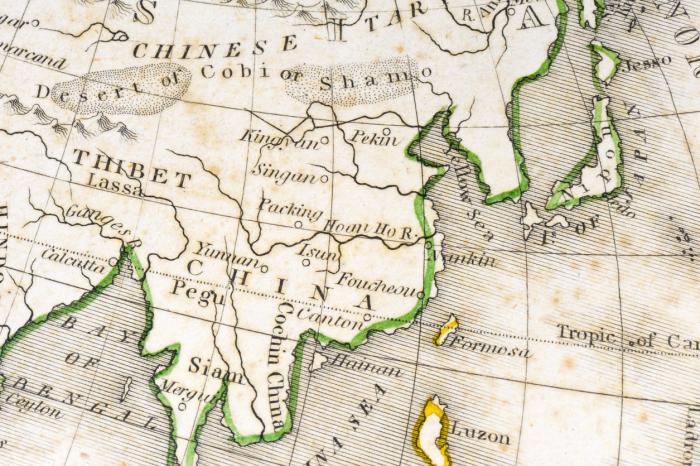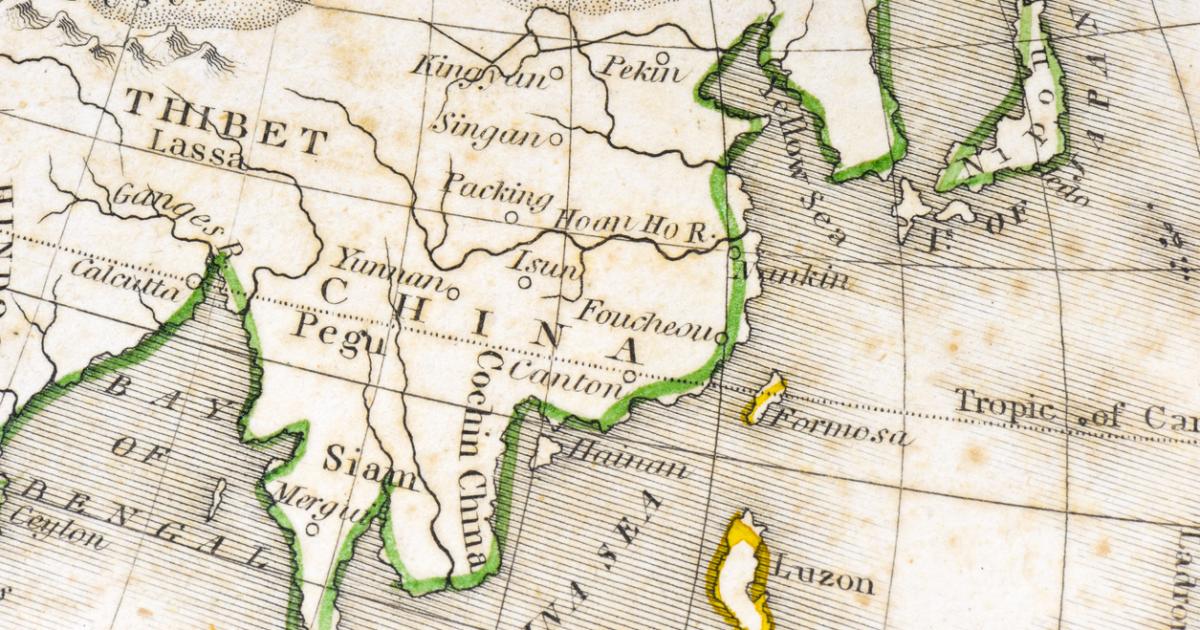- History
- World
Halford Mackinder began his sketch on a spare map in 1904 by putting his pencil down on a point near the seas north of Russia’s St. Petersburg, by the Kanin Peninsula. From there, he laid down a southward graphite trail, bending west to incorporate Moscow, then heading south once more, threading between the Black Sea and the Caspian Sea until he stopped barely above the Persian Gulf. From there, his hand changed direction, and he traced a 45 degree line northeast, driving sharply across Central Asia, staying ever so slightly west of Afghanistan’s Hindu Kush and confidently crossing the Central Siberian Plateau, back to Russia and its Lake Baikal, keeping west of the Sea of Okhotsk and finally reaching the East Siberian Sea after passing through the Chersky Range. He then rotated his pencil and placed a series of dots in the area he had just enclosed. He titled the space the Pivot Area. He wrote a few other words elsewhere, defining a general periphery outside the Eurasian line. It instantly became a provocative theory of world order, defining power through the realities of unchangeable, immutable geography.
Historical examination of this theory has tended to focus on European elements of this map for the simple reason that from the Enlightenment until World War II, Europe was the center of world power and order. In 1900, one in four people lived in greater Europe, and it also was the architect and center of what would become the world economy.
The United States, relegated to a tangential role in history on this map, in the Lands of the Outer Crescent, understandably preferred another theory that came into vogue at about the same time, one drawn by a sea captain with very different ideas. In Alfred Mahan’s mind, power wasn’t conferred by land and geologic features, but by the seas. His emphasis on sea power as the ultimate source of ordering strength fit comfortably with a simultaneous American ascendancy, peaking during and immediately after World War II. During the early 1940s, the world saw the ultimately victorious nation project immense military power across the Pacific and Atlantic Oceans to, in concert with its allies, decisively influence the centers of global power outside North America. For the next 70 years, the United States, largely without contest, controlled these oceans, securing the routes for a global economic order that emphasized free trade between all nations. The success of the United States, particularly as it overcame challenges by the Soviet Union, which largely inhabited the lands of power as stated by Mackinder’s theory, compounded the success of Mahan’s idea.
China’s dramatic rise in the 21st century will force a return to Mackinder’s world order structures and theory. This is because the center of world power, defined simply by population sizes, political efficiency, and economic capacity (Organski, World Politics), is moving away from the United States towards Eurasia, almost entirely because of the growth of Chinese power at the eastern end of the landmass. If world power is a marble on a flat board of the earth, over the last 100 years it has rolled from somewhere near the Meridian of Greenwich in Europe to North America, and now will roll back across the Atlantic, crossing over Western Europe and starting to edge towards China. The nature of China’s rise will determine the speed and exact trajectory of how the marble rolls. China’s signature foreign policy project, the Belt and Road Initiative, a Mackinder-esque view of the nature of power, is laying these tracks for future movement.
Through this project, China has, for the first time in history, defined the terms of a global discussion. Whether nations hate the BRI, are indifferent to it, or love it, every state is discussing it. While status quo powers are trying, almost frantically, to determine how to either resist or mitigate its effects, the countries in and around the southernmost sketches of Mackinder’s map are asking different questions. Having been on the receiving end of imperial behavior for centuries, they are acutely aware of the balance of global power, and are realizing that China’s rise and its BRI project afford an immense expansion of foreign policy options, away from the binary options of joining or resisting American world order plans. When another variable is inserted into an equation, options don’t double, they increase dramatically. It is therefore unsurprising that China has been welcomed with open arms into the region.
The Rise of Eurasia
There is plenty for these countries to discuss. The volume of trade across Eurasia, a geo-political term that the BRI is bringing back into vogue and which comprises the project’s general expanse, is the largest volume of global trade. Valued at approximately $2 trillion per year, Eurasian trade is twice the size of trans-Atlantic trade and substantially larger than trans-Pacific trade (Bruno Macaes, Belt and Road: A Chinese World Order). Moreover, the region between Berlin and Beijing has the highest overall potential for economic growth on the planet (Macaes). If Chinese power continues to increase, its ability to change regulatory norms by which trade is conducted, the Internet accessed, electric currents circulated, and rail gauges set will also continue to improve. In the decade to come, China will likely further influence or bypass altogether powerful bodies like the International Standards Organization that are the quiet pillars of the Western economic order.
China’s Belt and Road Initiative takes full advantage of these trends and accelerates them. With a paucity of details and a liberal use of words (Jon Alterman / Center for Strategic and International Studies), China’s foreign policy project has instituted the first world order paradigm shift in global thought since the fall of the Berlin Wall. Regardless of implementation, the world is discussing how to join or fight a Chinese foreign policy initiative.
The project is often compared to the Marshall Plan on the basis of major investments into infrastructure and economic development. But they are not the same. The Marshall Plan was designed to restore and rehabilitate an old world order that the Europeans had decided to destroy, with the only change being that America would lead that order instead of Europe. The BRI project, by contrast, is about developing an entirely new order. The geographic contours the project follows suggests that it is defined by an interest in bypassing American power rather than confronting it.
The linchpin for this effort to shape a new world order is the same geography that Mackinder’s pencil traced - the area just north of the Persian Gulf. Bridging Europe to Asia, this territory today is largely defined by Iran, with neighboring Iraq and Afghanistan enclosing the space like a tulip. China’s maps for the BRI flow through and around this space, generally avoiding an uncertain Russia. And it is in this southern tip of Mackinder’s map that China is investing increasing amounts of time, money and attention.
Iraq and Iran as the Key to Asian World Order?
It is curious that the Americans, the status quo power ostensibly interested in maintaining a hegemonic position and shaping, if not stopping, China’s rise, have rarely expressed any interest in thinking strategically about Iraq and Afghanistan in terms of how they relate to China.
Though China was never present in American thinking about their numerous wars since 2001, the Americans theoretically should enjoy an enviable ability to restrict or manipulate China’s BRI project in Mackinder’s Pivot Area. Having invested several trillion dollars, nearly two decades of effort, and sent thousands of young men and women to die in both Iraq and Afghanistan since 9/11, the United States should be able to attract or coerce governments and regimes in the region to follow its lead.
Unfortunately, it is not at all obvious what sustained US attention, investment, and expenditure of blood and treasure has gained for the North American power. Ten years of training Iraqi forces at enormous expense was wiped away when the Islamic State, a zealous Arab militia, conquered nearly one-third of Iraq despite being outnumbered and outgunned in key battles. In Afghanistan, the Taliban has pushed the Americans from the battlefield to the negotiating table, with all parties looking to end the conflict on whatever terms possible as quickly as possible.
While the region is complex and there are likely tactical successes on some level, what is clear is that none of the American investment into the region has translated into the ability to decisively influence the course of events in the Middle East and Central Asia. Events elsewhere in the region, primarily the conflicts in Syria and Yemen, or the stated goals of reducing regional Iranian intransigence, bear this out. This suggests that regardless of the ideas that the US seeks to advance, it lacks the capacity to implement them. Intentions, no matter how well funded, do not guarantee outcomes.
Paradoxically, all this American activity seems to have assisted China in the most important geography for the coming century. With China reinstating the primacy of economics and diplomacy over special forces, it can make strong appeals as a country with a coherent, economically-successful, ideologically attractive alternative to the Americans, providing populations wary of American behavior since 9/11 with a simple message: increase stability and get rich. That the Americans may have plenty of excellent counter-arguments is immaterial. What matters is how interested countries are in seeing what China has to say.
This message is being received well in this pivotal area, and inside Iran in particular. While they should be taken with a large grain of salt, public announcements have consistently reported Chinese investments totaling in the hundreds of billions of dollars, first a projection of $600 billion investment in 2016 and a subsequent $400 billion investment in 2019. While these are planned over the next decade and many events, like the coronavirus, may reduce or even stop the ability to actually develop these investments, China is clearly and consistently articulating an interest in nurturing the region’s development. China’s substantial investments in Pakistan’s Gwadar port, just on the other side of the Iranian border, support its investments in Iran. In neighboring Iraq, China is similarly increasing its investments in Basra, the fragile republic’s most southernmost access point to the sea. The first cargo shipment directly from China to Iran by rail arrived in 2016, completing the journey significantly faster than the same route by sea, which is also patrolled by the US Navy. Taken together, all these investments continue to improve China’s ability to influence the course of events in the Pivot Area.
While America tries to leave the region, increasingly focused on domestic issues and the ascendancy of smaller thinking, China continues to lay the groundwork for an interconnected Eurasia in precisely the same geographies from which the US is withdrawing.
The Belt and Road to Where?
The areas south of the Caspian Sea are not the endpoint for China’s Belt and Road Initiative, they are the critical geographic pivot point for China’s Eurasian dreams. They are the gateway to Eastern Europe, where China’s BRI investments are some of the most substantial and where China has enjoyed considerable success in peeling individual European nations away from the EU consensus.
Mackinder would appreciate this focus on Eastern Europe. As he stated, “Whoever controls Eastern Europe controls the Heartland; whoever controls the Heartland rules the World Island; whoever rules the World Island rules the world.” China’s continued expansion across Eurasia, increasingly secure through its control of Mackinder’s southernmost points in his Pivot Area via its economics-driven Belt and Road Initiative, will deliver to China the unique opportunity to create new world order structures across geographies that its chief competitor, the United States, has limited abilities to stop or influence.
How China develops this opportunity remains to be seen. Nothing is inevitable, and China faces plenty of obstacles as it feels its way across the landmass. Clever, patient and strategic American policymaking, particularly in collaboration with allies, could dramatically alter Chinese fortunes. What is clear, however, is that the rise of Eurasia will see the rise, once again, of Mackinder.
Matt Trevithick, a graduate student at Yale University’s Jackson Institute for Global Affairs, spent nine years across Syria, Iraq, Iran, and Afghanistan in higher education and international development.







